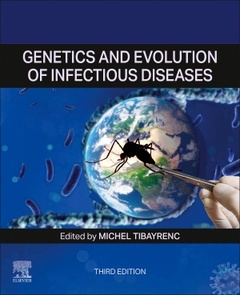Description
Genetics and Evolution of Infectious Diseases (3rd Ed.)
Coordinator: Tibayrenc Michel
Language: English
Subjects for Genetics and Evolution of Infectious Diseases:
720 p. · 19x23.4 cm · Hardback
Description
/li>Contents
/li>Biography
/li>Comment
/li>
Genetics and Evolution of Infectious Diseases, Third Edition discusses the evolving field of infectious diseases and their continued impact on the health of populations, especially in resource-limited areas of the world where they must confront the dual burden of death and disability due to infectious and chronic illnesses. Although substantial gains have been made in public health interventions for the treatment, prevention, and control of infectious diseases, in recent decades the world has witnessed the emergence of the human immunodeficiency virus (HIV) and the COVID-19 pandemic, increasing antimicrobial resistance, and the emergence of many new bacterial, fungal, parasitic, and viral pathogens. Fully updated and revised, this new edition presents the consequences of such diseases, the evolution of infectious diseases, the genetics of host-pathogen relationship, and the control and prevention strategies that are, or can be, developed. This book offers valuable information to biomedical researchers, clinicians, public health practitioners, decisions-makers, and students and postgraduates studying infectious diseases, microbiology, medicine, and public health that is relevant to the control and prevention of neglected and emerging worldwide diseases.
1. Virus Species 2. A Theory-Based Pragmatism for Discovering and Classifying Newly Divergent Bacterial Species 3. Population Structure of Pathogenic Bacteria 4. Diverse Strategies and Evolutionary Histories of Fungal Pathogens 5. Molecular Epidemiology of Pathogenic Microorganisms and The Predominant Clonal Evolution (PCE) Model 6. Coevolution of Host and Pathogen 7. Human Population Diversity and Transmissible Diseases 8. Pathogens as Tracers of Past Human Demography and Migrations 9. Evolutionary Responses to Infectious Disease 10. Infectious Diseases Genomics 11. Proteomics and Host/Pathogen Interactions: A Bright Future? 12. The Evolution of Antibiotic Resistance 13. Evolution of Resistance to Insecticide in Disease Vectors 14. Genetics of Major Insect Vectors 15. Modern Morphometrics of Medically Important Insects 16. Multilocus Sequence Typing of Pathogens 17. Omics, Bioinformatics, and Infectious Disease Research 18. Genomics of Infectious Diseases And Private Industry 19. Biodiversity, Ecology, and Zoonoses 20. Genetic Exchange in Trypanosomatids and its Relevance to Epidemiology 21. Genomic Insights into the Past, Current and Future Evolution of Human Parasites of the Genus Plasmodium 22. Host Adaptation in the Mycobacterium Genus: An Evolutionary and Genomic Perspective 23. Evolution, Phylogenetics and Phylogeography of Mycobacterium Tuberculosis 24. The Evolution of Staphylococcus Aureus 25. Origin and Emergence of HIV/AIDS 26. Evolution of SARS Coronavirus and the Relevance of Modern Molecular Epidemiology 27. Ecology and Evolution of Avian Influenza Viruses
Dr. Michel Tibayrenc has worked on the evolution of infectious diseases for more than 45 years. He is a director of research emeritus at the French Institut de Recherche pour le Developpement (IRD) and the founder and editor-in-chief emeritus of the Elsevier journal Infection, Genetics and Evolution. From 1996-2021 he was the founder and principal organizer of Elsevier’s international MEEGID congress (Molecular Epidemiology and Evolutionary Genetics of Infectious Diseases). He has held professional appointments in France, Algeria, French Guiana, Bolivia, Thailand, and the United States; is the cofounder of the Bolivian Society of Human Genetics; and is a fellow of the American Association for the Advancement of Science.
- Takes an integrated approach to infectious diseases
- Provides the latest developments in the field of infectious diseases
- Focuses on the contribution of evolutionary and genomic studies for the study and control of transmissible diseases
- Includes updated and revised contributions from leading authorities, along with six new chapters




